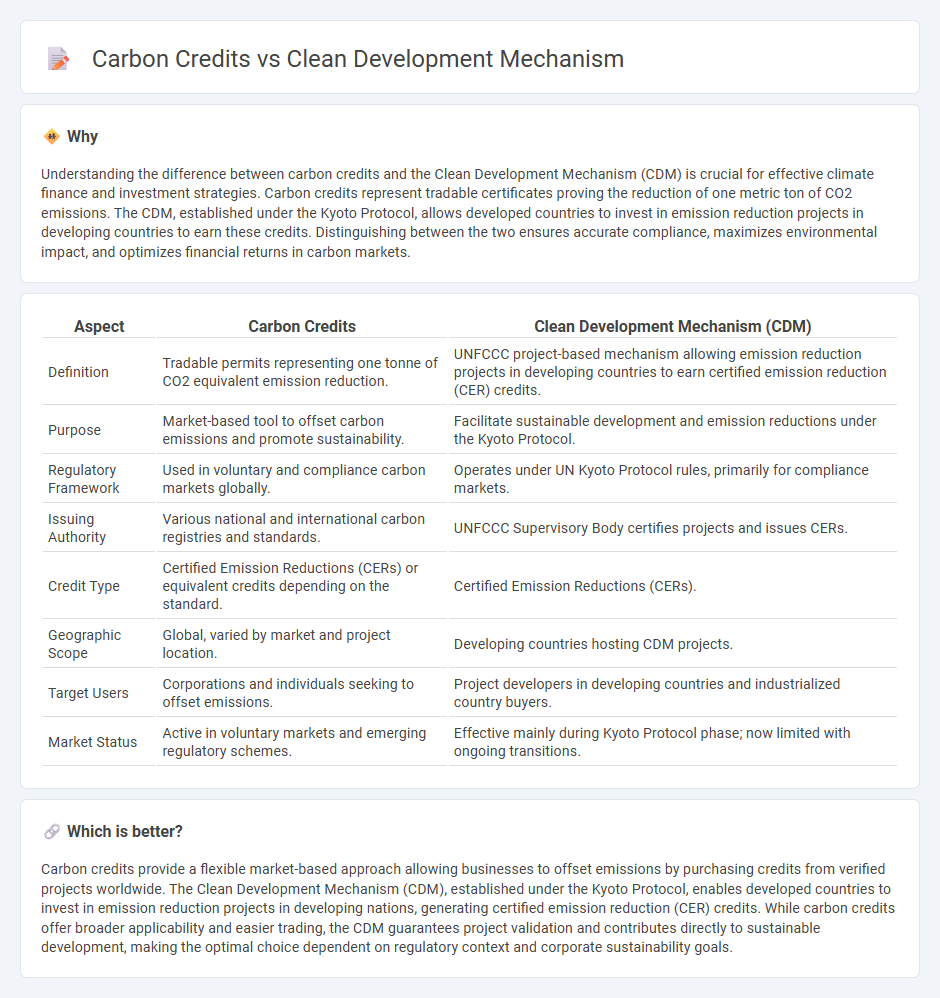
Carbon credits represent tradable certificates allowing companies to offset their greenhouse gas emissions by investing in environmental projects, while the Clean Development Mechanism (CDM) is a specific United Nations framework facilitating emission reduction projects primarily in developing countries to earn certified emission reduction (CER) credits. Both mechanisms play crucial roles in global carbon markets by promoting sustainable investments and compliance with international climate agreements. Explore how these innovative financial tools drive environmental accountability and support climate goals.
Why it is important
Understanding the difference between carbon credits and the Clean Development Mechanism (CDM) is crucial for effective climate finance and investment strategies. Carbon credits represent tradable certificates proving the reduction of one metric ton of CO2 emissions. The CDM, established under the Kyoto Protocol, allows developed countries to invest in emission reduction projects in developing countries to earn these credits. Distinguishing between the two ensures accurate compliance, maximizes environmental impact, and optimizes financial returns in carbon markets.
Comparison Table
| Aspect | Carbon Credits | Clean Development Mechanism (CDM) |
|---|---|---|
| Definition | Tradable permits representing one tonne of CO2 equivalent emission reduction. | UNFCCC project-based mechanism allowing emission reduction projects in developing countries to earn certified emission reduction (CER) credits. |
| Purpose | Market-based tool to offset carbon emissions and promote sustainability. | Facilitate sustainable development and emission reductions under the Kyoto Protocol. |
| Regulatory Framework | Used in voluntary and compliance carbon markets globally. | Operates under UN Kyoto Protocol rules, primarily for compliance markets. |
| Issuing Authority | Various national and international carbon registries and standards. | UNFCCC Supervisory Body certifies projects and issues CERs. |
| Credit Type | Certified Emission Reductions (CERs) or equivalent credits depending on the standard. | Certified Emission Reductions (CERs). |
| Geographic Scope | Global, varied by market and project location. | Developing countries hosting CDM projects. |
| Target Users | Corporations and individuals seeking to offset emissions. | Project developers in developing countries and industrialized country buyers. |
| Market Status | Active in voluntary markets and emerging regulatory schemes. | Effective mainly during Kyoto Protocol phase; now limited with ongoing transitions. |
Which is better?
Carbon credits provide a flexible market-based approach allowing businesses to offset emissions by purchasing credits from verified projects worldwide. The Clean Development Mechanism (CDM), established under the Kyoto Protocol, enables developed countries to invest in emission reduction projects in developing nations, generating certified emission reduction (CER) credits. While carbon credits offer broader applicability and easier trading, the CDM guarantees project validation and contributes directly to sustainable development, making the optimal choice dependent on regulatory context and corporate sustainability goals.
Connection
Carbon credits function as tradable certificates representing a reduction of one metric ton of CO2 emissions, facilitating organizations in meeting regulatory requirements or voluntary climate goals. The Clean Development Mechanism (CDM), established under the Kyoto Protocol, enables emission-reduction projects in developing countries to generate Certified Emission Reduction (CER) credits, which can be sold or traded as carbon credits. This system incentivizes sustainable development while allowing industrialized nations to comply with emission targets through market-based carbon credit exchanges.
Key Terms
Emissions Reduction
The Clean Development Mechanism (CDM) facilitates emission reduction projects in developing countries, generating Certified Emission Reduction (CER) credits that industrialized nations can purchase to meet targets under Kyoto Protocol. Carbon credits represent tradable permits or certificates allowing entities to emit a specified amount of greenhouse gases, with each credit typically equivalent to one ton of CO2 reduced or avoided. Explore how these mechanisms drive market-based solutions for global emissions reduction strategies and foster sustainable development.
Certified Emission Reductions (CERs)
Certified Emission Reductions (CERs) are carbon credits generated under the Clean Development Mechanism (CDM), a framework established by the Kyoto Protocol to promote sustainable development and emission reductions in developing countries. CERs represent quantified emission reductions that can be traded or used by industrialized countries to meet their carbon reduction targets. Explore deeper insights into how CERs facilitate global carbon markets and funding for green projects.
Cap-and-Trade
The Clean Development Mechanism (CDM) enables industrialized countries to implement emission reduction projects in developing nations, generating certified emission reductions (CERs) used to meet Kyoto Protocol targets, while carbon credits represent tradable permits allowing entities to emit a specific amount of greenhouse gases within cap-and-trade systems. Cap-and-trade programs establish a limit on total emissions and enable companies to buy or sell carbon credits to comply with caps, fostering cost-effective emission reductions. Explore the strategic differences and benefits of CDM and carbon credits in global carbon markets to optimize environmental impact.
Source and External Links
Clean Development Mechanism (CDM) - The CDM, established by the Kyoto Protocol in 1997, allows industrialized countries to earn certified emission reduction (CER) credits by funding emission-reduction projects in developing countries, promoting sustainable development and multiple benefits like GHG reduction, renewable energy, and poverty alleviation.
Clean Development Mechanism - Wikipedia - The CDM is a UN-run offset scheme under the Kyoto Protocol enabling industrialized countries (Annex I) to invest in emission reduction projects in developing countries and claim certified emission reductions (CERs) toward their emission targets.
What is Clean Development Mechanism? - BYJU'S - CDM projects must produce measurable climate mitigation benefits and undergo phases including project identification, government approval, development, verification, registration, and certification to qualify for emission reduction credits.
 dowidth.com
dowidth.com